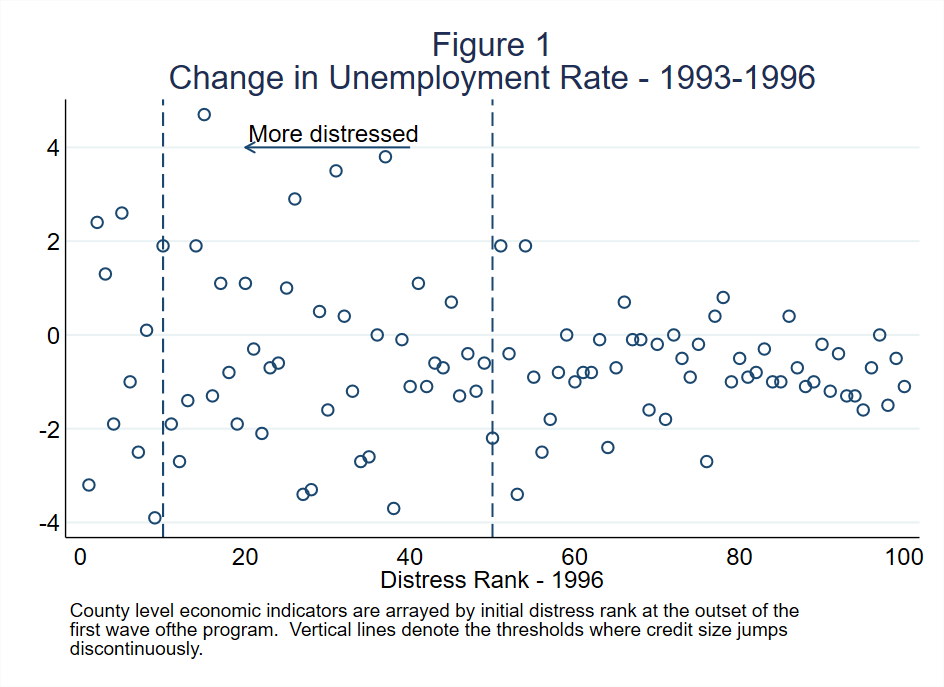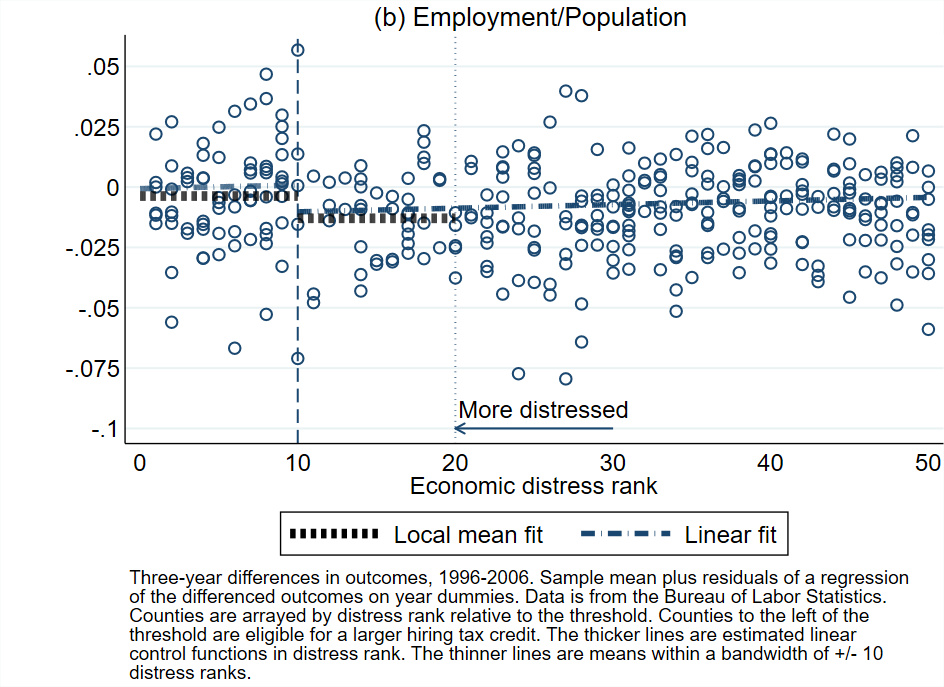The Efficacy of Hiring Credits in Distressed Areas
Published:
Hiring tax credits are a commonly used tool at the state level and as part of federal programs to address both short-run downturns and longer-run economic distress. Evidence has found mixed results, with null or positive employment effects depending on the characteristics of the program introduced. The empirical evaluation of these policies is difficult as their enactment is typically endogenous to expected economic prospects or local economic distress.
In a research paper with Michael Suher, we examine a series of tax credit programs enacted in North Carolina, whose structure enables causal estimates of policy impacts. The programs assign credit size based on an economic distress rank. They include thresholds at which credit size jumps discontinuously, allowing for regression discontinuity (RD) estimates.
North Carolina’s Hiring Tax Credit Programs
We focus on the William S. Lee program, which began in 1996 to 2006 in North Carolina. This program gave fiscal incentives to help the economy of the more distressed counties. The 100 counties were ranked according to a formula that estimated their level of distress. The Lee program specified county rankings based on unemployment rates, income per capita, and population growth. Each county received a score for each of these three rankings. Afterward, the score was summed and ordered to create the 1 to 100 distress rank for the coming year. With this rank, counties were assigned to three different tiers. Credits of 12,500 were available to the ten most distressed counties designated as tier 1. This sum was paid out over four years if the beneficiary maintained the size of its payroll. The next 40 counties were assigned to tier 2 and could benefit from credits between 3,000 and 4,000 per new hire. In comparison, the last 50 counties in the least distressed tier 3 could receive between 500 and 1,000. Only firms in specific sectors, such as manufactures, were eligible. The county rank changed each year, so deductions vary over time.
Empirical Strategy
The estimation of the policy’s impact takes advantage of the fact that the relationship between the economic distress classification and the counties’ economic performance before the start of the program is weak. The amounts of the deductions vary discontinuously when crossing thresholds in the classification. Figure 1 shows the relationship between the tier assignment in 1996 and the change in the unemployment rate from 1993 to 1996. First, there is no discontinuity in the past evolution of county unemployment across the allocation thresholds. Thus, when comparing counties on both sides of the thresholds, similar counties are observed that differ in the amount of tax deduction. Second, the correlation between unemployment evolution before 1996 and the classification of economic difficulty is weak, which allows estimates to be made even using counties far from the thresholds.
 |
To estimate the program’s effect, we compare the evolution of employment and unemployment between counties of levels 1 and 2. Exploiting the discontinuity in the allocation of deductions and considering that the counties can change levels each year, we estimate dynamic discontinuous regression models that control for each county’s deduction history. The data used comes from the Bureau of Labor Statistics, the Census Bureau, and the North Carolina Department of Commerce.
Results
 |
 |
Figure 2 shows changes in the unemployment rate and employment/population ratio for counties three years after assignment to a tier. Each point is a combination of county and year of assignment. Since the tier assignation is repeated annually, each county is observed each year. The observations are ordered by classification of economic difficulty. Those to the left of the vertical segmented line correspond to tier 1 and the highest deduction. We observe that the relationship between the classification and the changes in unemployment/employment is approximately linear. It has a discontinuity when crossing the threshold. We estimate that three years after being classified at tier 1, counties have a 0.5 pp lower unemployment rate than they would have had without the program. They also have a one pp higher employment/population ratio. The estimates are similar if we only consider the counties closest to the threshold.
When carrying out difference-in-difference estimates, as is traditional in this literature, we do not find significant employment effects. We attribute these null effects to a bias caused by endogeneity in program allocation: employment in tier 2 counties tends to grow faster even without the program. The RD estimates control for this bias, and they offer a different view of program effects.
We estimate that each new job costs about 7,400 dollars in tax deductions. This cost compares favorably with that of other employment generation policies. Thus, the results suggest that hiring tax deductions are effective in increasing employment in economically depressed areas.
